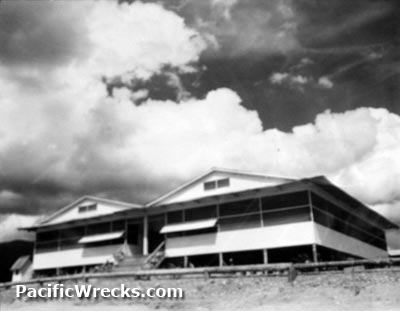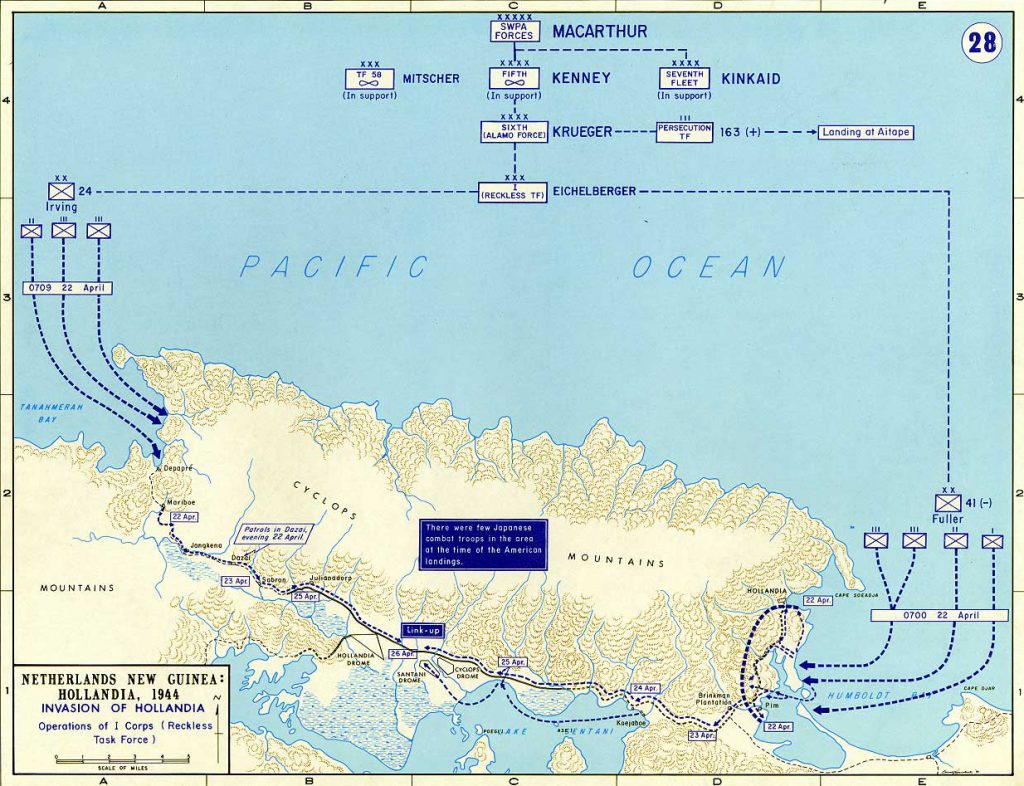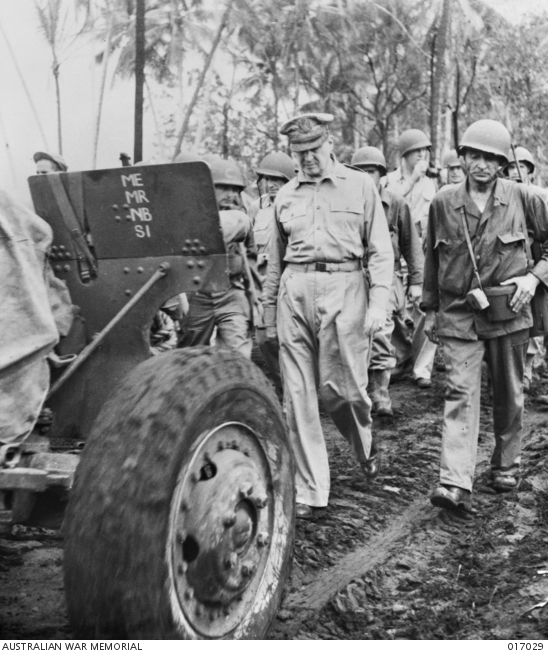From Camp Columbia in Brisbane to Camp G in Hollandia

Advance headquarters was established at Port Moresby early in 1943.
After the Battle of Hollandia (see below) General Douglas MacArthur moved his staging camp from Camp Columbia in Brisbane to Hollandia in Netherlands New Guinea (present-day Jayapura in West Papua). Already in In early 1944, MacArthur determined that the area on north of Netherlands New Guinea (NGN) should be seized and developed into a staging post for their advance along the north coast of the island into the Netherlands East Indies and to the Philippines.
Parts of the US Army were trained in Australia for this operation.

MacArthur made Hollandia a centre from which the fight against the Japanese in the Pacific was coordinated. The town of Hollandia did not offer any facilities a road network of hundreds of kilometres and a large number of buildings were built in a very short time.
They also made the Sentani airfields operational and used them during heavy fighting further inland during the Battle of Driniumor River. Both Humboldt Bay and Tanahmerah Bay were developed with naval base, ammunition, repair and fuel facilities.
The site, which was subsequently renamed “Base G” and accommodated more than 100,000 American soldiers. General MacArthur moved to Hollandia with the staff of the American Sixth Army and took up residence in a villa on the slopes of the Cyclops Mountains overlooking Lake Sentani. He left for the Philippines in January 1945. The Americans would remain in Hollandia until January 1946, after which authority over Hollandia was transferred back to the Dutch when the Korps Speciale Troepen (Special Forces) took over military command.
Video below: During WWII, stories circulated in the Pacific Theater that General MacArthur lived in a luxurious villa in Hollandia. Amanda Williams and Jim Zobel of the MacArthur Memorial discuss this “million dollar mansion” and what might have started the rumor mill.
Some more background information
Hollandia

What became Hollandia started 1909 as a military camp in the jungle and they named it Kloofkamp. They had done very little in the development of NGN until the Germans started to establish their military presence in the eastern part of the island, now Papua New Guinea. The camp grew into what became. the capital of NGN, thanks to its position on the Humboldt Bay it became a major port on the north coast of the island. At this stage the west part of the island was part of the Netherlands East Indies and Hollandia was the only anchorage on the north coast of the territory between Wewak to the east, and Geelvink Bay to the west.
The town was situated on the east side of a headland separating Humboldt Bay to the east and Tanahmerah Bay,
On April 19, 1942, Hollandia was occupied by the Japanese army and all Europeans were deported to Ambon and interned. The Japanese turned Hollandia into an important base and used the place to store large supplies of food, clothing and medicine. They stationed two infantry regiments and a marine regiment there and built three airfields at Lake Sentani.
They planned to use it as a base for their expansion towards the Australian mandated territories of Papua and New Guinea. Japanese plans to occupy Port Moresby were negated by losses during the Battle of the Coral Sea and Battle of Milne Bay. Consequently, Japanese efforts to develop the area were delayed throughout 1943 and 1944.
Battle of Hollandia

After their landings in Hollandia, the Americans begun to drive the Japanese out of NGN and had conquered parts of eastern New Guinea, isolating the Japanese by cutting off their supply lines.
Because the Japanese expected an American attack on the coastal town of Wewak, General Hatazō Adachi and his 18th Army had transferred part of his troops from their headquarters at Rabaul to Wewak. However, General Douglas MacArthur decided to accelerate the advance against the Japanese and carried out the surprise attack on Hollandia on April 22, 1944. Lieutenant General Robert Eichelberger – the former commander of Camp Cable in Brisbane – was in charge of the landing operation that day under the code name “Reckless”. The troop strength consisted of 37,500 infantrymen and 18,000 non-combatants. Bombing destroyed 245 Japanese aircraft on the ground. The Japanese were completely surprised by the landing and fled en masse into the jungle.
Air and naval support also consisted largely of U.S. assets, although Australia also provided air support during preliminary operations and a naval bombardment force. The main contribution from the Dutch was intelligence services.
Pre-landing reconnaissance efforts were hampered by the destruction of the Australian scouting party that has landed in the area by submarine in late March, and the reality of the terrain was only discovered through aerial intelligence that arrived too late for the Australians.
The landings in Hollandia and the more westerly Tanahmerah Bay, were the first landings in occupied Dutch territory.
Shortly before, an American submarine destroyed air support upon landing in Tanahmerah Bay. Japanese ships were on their way from the Palau archipelago (north of the Vogelkop- Bird Head Peninsula in NGN) to Hollandia with the latest Japanese war equipment. Nearly an entire Japanese regiment, tanks, armoured cars and other equipment were taken out by Allied forces.
From April 21 to 27, the Americans carried out amphibious landings to capture Hollandia and the airstrips at Sentani. A Dutch unit from Australia was also involved in these landings, under the command of Colonel Conrad Giebel of the KNIL.
From here the Allies were able to mount bombing raids on Japanese positions as far west as Biak, making them useless for air operations. The landings at Hollandia and Aitape were followed, just four weeks later, by landings at Wakde, Sarmi and Toem, to the west.
Allied casualties were amazingly low 152 but an estimated 3300 Japanese were killed.
During this period, many Papuans come into contact with the military violence of the 20th century for the first time.
Australian 6th Army Division
In late 1944, as U.S. troops were released for service elsewhere in the SouthWest Pacific Theatre, leadership of the Western New Guinea Campaign was now passed on to the Australians. They began clearing the remnants of General Hatazō Adachi army from coastal areas starting around Aitape and advancing eastward to the Wewak area.
On May 11, 1945, Adachi’s Wewak headquarters fell. Offensive operations continued in the hinterland until General Adachi surrendered his sword and men to the Australian 6th Army Division in a ceremony near Wewak on September 13, 1945. This ceremony occurred 11 days after the formal Japanese surrender.
Netherlands Indies Civil Administration
The Netherlands Indies Civil Administration (Dutch: Nederlandsch-Indische Civiele Administratie, NICA) was a semi-military organisation, established in April 1944.
The above-mentioned Dutch unit that landed with the US troops included the first NICA detachments. NICA staff consisted of Dutch, Indos, and native Indonesian military or militarised personnel that wore uniforms. The general management was in the hands of Colonel Conrad Giebel, who had the rank of Staff Officer NICA (SONICA). NICA’s responsibility to reestablish Dutch local governance. By the time Japan capitulated, NICA units already established civil administration in Western New Guinea (i.e. at Hollandia, Manokwari, and on the Schouten Islands), in the Moluccas (on Morotai), and in Borneo (on Tarakan and at Balikpapan).
Below is an amateur film made in 1944 by Mr. Hans Anton Maurenbrecher about fighter pilots of the 120 Squadron during their stay in Merauke in the Dutch East Indies. Images of the trip from Merauke to Hollandia. Source: Netherlands Ministry of Defence.
Sources:
Nieuw-Guinea in de Tweede Wereldoorlog
